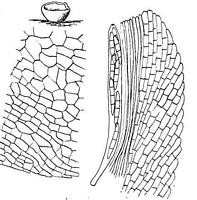|
 Pseudohelotium haematoideum Pseudohelotium haematoideum
SynonymsPeziza haematoidea
Pezizella haematoidea
BiostatusPresent in region - Indigenous. Endemic
Images (click to enlarge)
Caption: FIG. 33. Pseudohelotium haematoideum. Habit. sketch x 8, details x 660 |
Article: Cooke, M.C. (1879). New Zealand fungi. Grevillea 8(46): 54-68.
Notes: Similar to P. rubella, P., but firmer, and with different fruit.
Article: Saccardo, P.A. (1889). Discomyceteae et Phymatosphaeriaceae. Sylloge Fungorum 8: 3-859 Padua: (http://194.203.77.76/LibriFungorum/Search.asp?ItemType=I).
Habitat: in ligno decorticato Waitaki Novae Zelandiae.
Notes: P. rubella subaffinis.
Article: Dennis, R.W.G. (1961). Some inoperculate Discomycetes from New Zealand. Kew Bulletin 15(2): 293-320.
Description: Apothecia scattered, subsessile, superficial, smooth, orange coloured throughout, disc
concave, I.5 mm. across, margin obtuse, even. Excipulum composed of rows of short, thin-walled, prismatic
cells, 3-4 µ wide, lying at a low angle to the surface, flesh formed of similar
but larger angular cells; asci cylindric-clavate, 8-spored, 90 x 7 µ, the small pore blued by Melzer's reagent;
ascospores biseriate, fusiform, 1- then 3-septate, 16-21 x 2.5 µ; paraphyses filiform, obtuse, 2 µ wide.
Notes: I do not know a fully appropriate genus for this little fungus. In most systems it will key to
Belonidium but the type of that, B. aeruginosum Dur., is a Dasyscyphus. Podobelonium
(Sacc.) Sacc. at first sight appears to offer a solution but of its four foundation species two
belong to Belonioscypha, one to Strossmayeria and the fourth, Helotium capense Cooke &
Kalchbr., appears to me to be a typical Helotium. Actually P. haematoidea seems nearest to
Orbiliopsis von Höhnel but that name is unfortunately unavailable since it is a later homonym
of Orbiliopsis Sydow. Pseudohelotium offers a reasonable place for the species but it differs
from P. pineti in its smooth receptacle, more waxy texture and probably unbranched
paraphyses.
|